Eating healthy doesn't have to be expensive. Instead of dropping your paycheck in one outing, try out these tricks to eat healthy for less.

21 Smart Ways To Eat Healthy on a Super Tight Budget

About the experts
|
Highlights
|
When you’re feeling the squeeze of rising prices in your grocery bill, knowing how to eat healthy on a budget can seem like an obstacle course. Yet nutrition experts emphasize that you’re not alone. “The current food system can be hard to navigate,” explains Sandra Zhang, MS, RDN, LDN, registered dietitian nutritionist and pediatric dietitian at the Frances Stern Nutrition Center at Tufts Medical Center.
She explains that processed foods are engineered to be appealing instead of nutritious so that people will buy more. “Because these processed foods are sold at higher volumes, their production and distribution have been optimized to be more efficient, so they are cheaper and even more appealing to consumers.”
Still, even the prices of processed foods have gone up, says Julia Zumpano, RD, LD, a registered dietitian with the Cleveland Clinic Center for Human Nutrition. “I think all food is expensive,” Zumpano says. But she adds that it’s a bit of a misconception that you can’t eat healthy on a budget. “A pint of blueberries costs about the same as an eight-ounce bag of potato chips, [but] we seem to justify the chips more.”
Simply replacing your unhealthy food options with healthy ones will at least keep your grocery bill about the same, she says. However, our experts offer some serious cost-saving advice that prioritizes healthy eating and your budget.
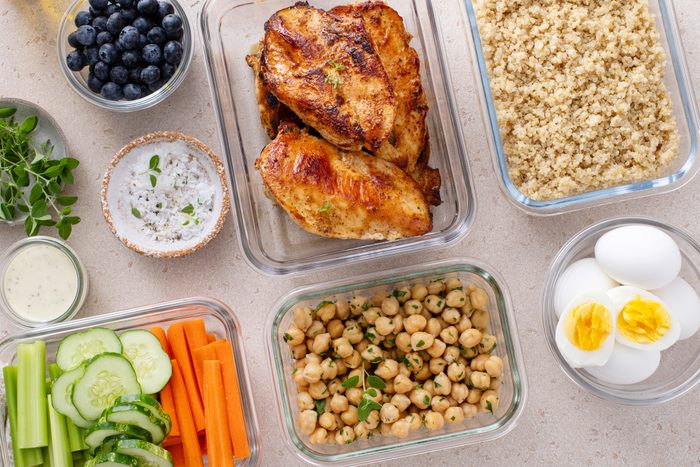
1. Plan your meals
Cooking more will help your budget, Zumpano says. She explains, “Pre-made, pre-cut, and pre-portioned foods are more expensive.”
To be conscious of your health, budget, and time, plan your meals for the week in advance, says JaLorean Hayes MPH, BSN, RN, IFNCP, a registered nurse, public health expert, and founder of Meal Maps.
Erika Allen, MA, PhD, is the founder and CEO of Urban Growers Collective, an organization focused on community food security. She recommends using apps or websites that help make meal planning a habit—such as Whisk or Budget Bytes—which have meal planning features, batch cooking ideas, and customizable filters for budget, time, and dietary needs.
She also points to EatFresh.org for nutrition tips, low-cost healthy recipes, and resources for SNAP (Supplemental Nutrition Assistance Program)-eligible households.
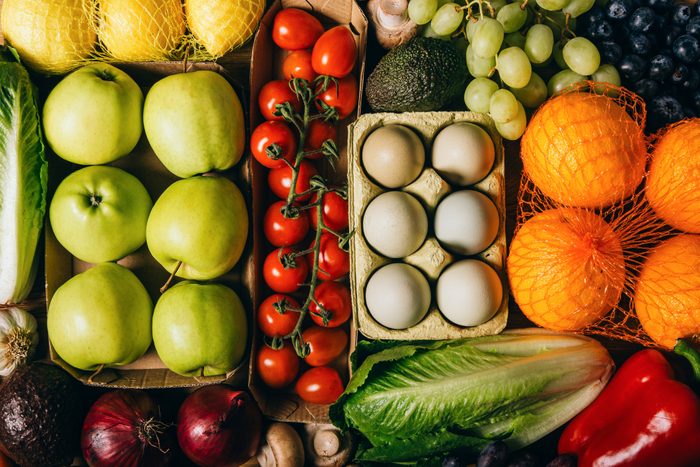
2. Then stick to your plan and prep
“Make a shopping list of items in each food group beforehand to make sure you are including all the nutrients you need,” says Zhang. “This [also] decreases purchasing unnecessary items,” adds Hayes.
“By making a list and sticking to it, you will buy only what you need instead of what looks good at the moment,” says Maya Rams Murthy, RD, MPH, the CEO and co-founder of Food Health Collective. “Incorporate using dinner leftovers for lunch the next day in your grocery list as well to cut down on the bill as well as food wastage.”
Once you’re back home, meal prepping can be helpful for making food in bulk, cutting down costs in both money and time, says Zhang. “But meal prepping does not have to yield ready-to-eat meals,” she explains. “It can simply be prepping produce or protein foods beforehand,” she says, such as blanching and freezing vegetables in bulk.
Buying frozen veggies is a very budget-friendly choice (which we’ll get to below), but if you snag a deal on local, in-season produce at your farmer’s market, bulk buying and freezing vegetables yourself can be even cheaper.
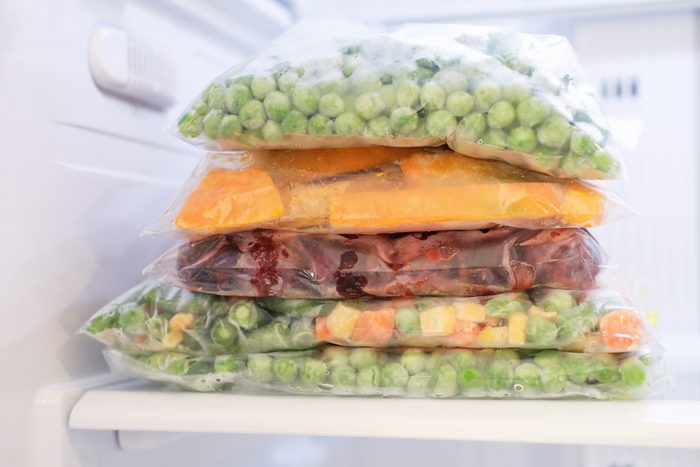
3. Go for frozen vegetables
Fresh vegetables can be expensive—especially if they’re out of season—but frozen vegetables can actually give you more bang for your buck. Not only are they typically cheaper, but frozen veggies contain comparable vitamins and minerals when compared to fresh veggies.
“Most of these foods are pre-picked, pre-washed, and sometimes cooked,” Zhang says. “Items like frozen fruits and vegetables, especially, help prevent unused foods from spoiling.”
But while you’re browsing the frozen foods section, “Skip frozen vegetables that include a sauce or seasoning,” says Pam Nisevich Bede, MS, RD, CSSD, LD, a dietitian for Abbott’s EAS Sports Nutrition. “Often, you’re paying extra for salt and cheaply made sauces.”
Frozen vegetables may actually give you more bang for your buck, too. They maintain greater vitamins and minerals when compared to fresh veggies.
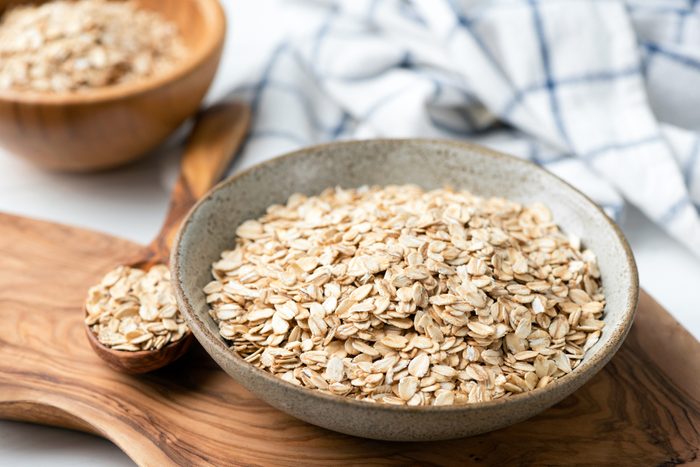
4. Eat oats for breakfast
When it comes to eating healthy on a budget, oats are a go-to for a quick breakfast or even baking.
“Oats are also a great source of beta-glucan, which is a fiber known to reduce cholesterol and improve cardiovascular health,” says Bede. This type of fiber in oatmeal is also known to have a strong effect on satiety, or how full you feel. That means your day with a hearty helping of beta-glucan can help keep you from splurging on a mid-morning snack to tide you over until lunch.
“I often buy oats in bulk from the farmer’s market,” Bede says. “They’re high quality and inexpensive.” Many supermarkets also offer oats in bulk.
Make life even easier by prepping overnight oats the night before. Here’s one nutritionist’s go-to overnight oats recipe.
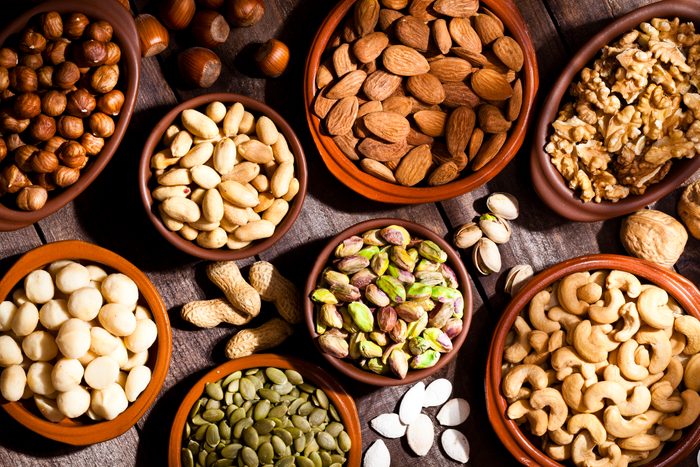
5. Buy nuts in bulk
Nuts are another healthy food that cost much less if you buy them in bigger quantities.
“Skip overly oiled and salted nuts, and instead buy nuts from the bulk section,” says Bede. “Nuts are a great source of heart-healthy fats and essential vitamins and minerals. Buy them whole and chop or prep on the fly for baking needs. Buying in bulk saves you much more money versus buying a few ounces at a time from the baking aisle.”
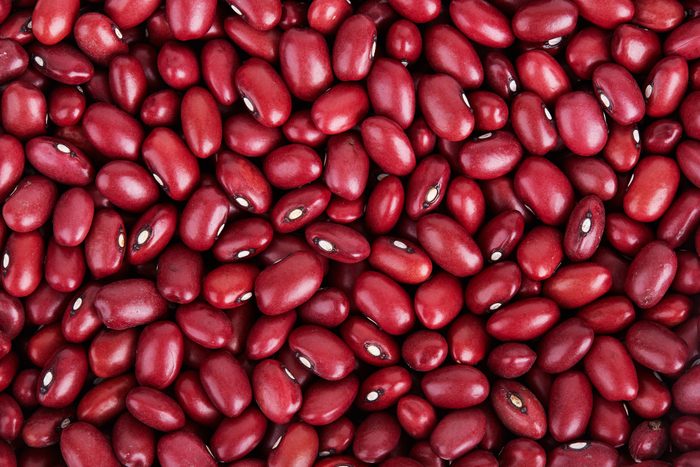
6. Buy beans in bulk, too
“Both dried and canned beans are extremely inexpensive,” says Rizzo. Depending on the brand, a can of beans can cost less than $1—which can serve up to 15 grams of protein for less than 300 calories. Beans are rich in iron and considered of the best sources of plant-based protein.
Beans and legumes like lentils are also much cheaper when you buy in bulk, especially if you get the dried versions, Zumpano says. Canned beans are often more convenient since there’s no preparation required—and while not as cheap as the dried versions, they can still be inexpensive if you get multipacks, she says.
Beans and legumes are also great sources of minerals, vitamins, protein, and fiber, Zhang adds. And when added to your meal, that protein-fiber combo, in particular, means you’ll feel fuller for longer. This nutritional strategy is great for your wallet because fewer high-nutrient, satiating meals will be less expensive than many low-nutrient meals to keep your hunger at bay throughout the day.
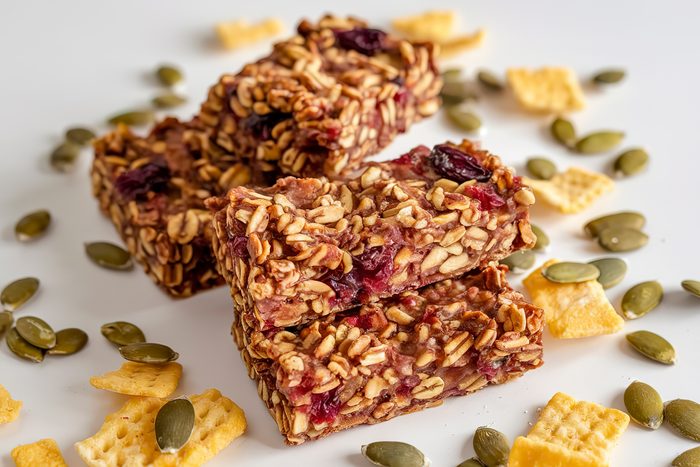
7. Go generic
Many snacks, whole-grain cereals, and even organic produce are available under the store brand.
“These foods are held to the same national standards of major brand name products, which means that, nutritionally, they are equivalent in quality,” says Murthy. “Don’t pay more for pretty packaging.”
Past research, such as one 2012 report, has suggested that generic products can save you up to 44%—and a 2022 report from Marketplace.org says, on average, store brands cost 30% less.
For example, at Walmart:
- Name brand Goya chickpeas cost about $1.40 per can, while Walmart’s in-house “Great Value” brand costs $0.94 per can.
- A 32-ounce tub of Chobani Greek yogurt costs $5.97, while Walmart’s “bettergoods” brand alternative costs $3.97 for the same size.
- A 16-ounce box of Barilla penne pasta costs $1.84, while Walmart’s “Great Value” version costs $1.18.
- Justin’s peanut butter is $7.32 for a 28-ounce jar—while Walmart’s “Great Value” natural peanut butter costs $3.64 for a 40-ounce jar.

8. Shop seasonal
Produce is not always the cheapest thing in the supermarket, but buying what’s in season makes it a great option for eating healthy on a budget.
“In the summer, you can find watermelon, berries, and corn for a fraction of the cost of apples and kale,” says Natalie Rizzo, MS, RD, an NYC-based registered dietician. “Because those grow best in the summer, there’s an abundance of them, and they can sell them for cheaper.”
Depending on the time of year, shopping seasonally also means you can buy local produce, like from a farmer’s market. These products tend to be cheaper since there’s less cost added on from processes such as shipping, packaging, and storage.
Allen recommends checking out Seasonalfoodguide.org to help you find what’s in season near you. “Buying seasonal produce is cheaper and more nutrient-dense,” she adds.

9. Opt for ugly produce
Often, if a piece of produce has a cosmetic deformity, the store won’t even put it out for sale. In fact, 2021 research from the Journal of Retailing and Consumer Services estimates that annually, 6 billion pounds of edible fruits and vegetables go to waste because they’re “ugly”—as in off-size, misshapen, discolored, or have other “cosmetic” issues that don’t impact the food’s nutritional value.
What’s more, the research says that US merchants often sell this ugly produce for 30 to 50% less than its normal prices.
“If you ask the grocer about the ugly produce, they may be willing to sell it at a fraction of the cost,” Rizzo confirms. “And there’s nothing wrong with it other than the fact that it looks different.”
To make it even easier, there are services that buy ugly produce straight from the farm and resell it at a steep discount. Two great delivery options are Imperfect Foods and Misfits Market, which sell ugly produce as well as items like less popular cuts of meat and still-good pantry items with outdated packaging.
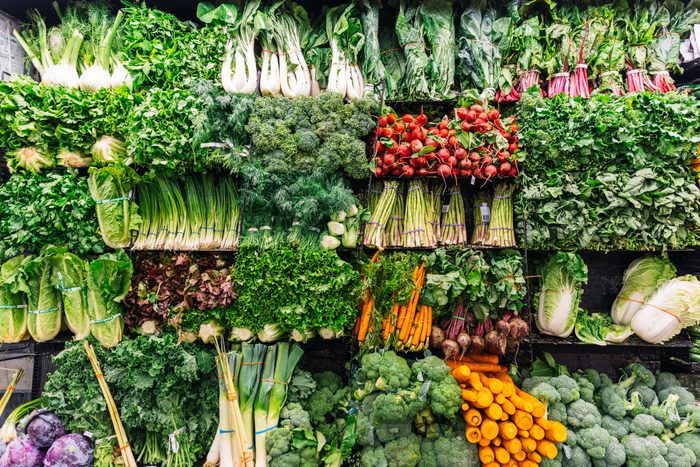
10. Look for sales
It might take some extra work, but keep your eye out for special sales and coupons that give discounts on healthy foods.
“Supermarkets have different weekly specials, and sometimes those prices are much lower than their competitors,” says Rizzo. “I suggest looking for sale signs in the store and buying the brands that are on sale.”
This can even make your meal planning easier, Hayes says. Check out what’s on sale this week and use that to inspire your meal planning and prep while further increasing your savings.
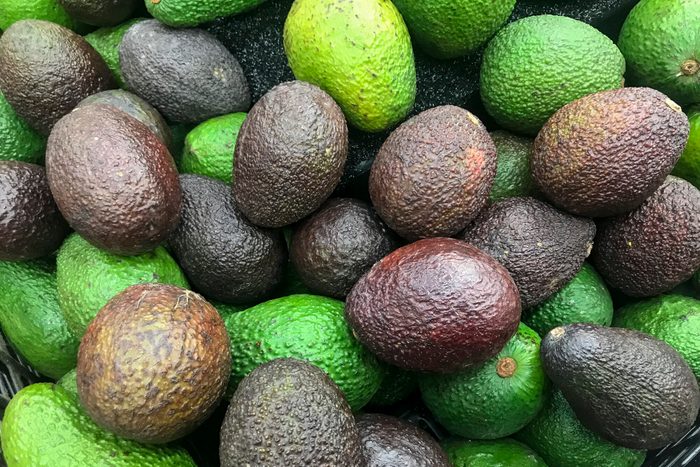
11. Don’t always go organic
“It’s more costly to produce and distribute organic foods, which is reflected in the price,” Zhang explains.
While buying organic food can help you avoid unwanted pesticides or other chemicals, it’s unnecessary for certain produce, like bananas or avocados, that have a peel for protection.
The Environmental Working Group (EWG) analyzes produce based on amounts of pesticide residue, and its “Clean Fifteen” also includes:
- Sweetcorn
- Pineapple
- Onions
- Papaya
- Frozen sweet peas
- Asparagus
- Honeydew melon
- Kiwi
- Cabbage
- Mushrooms
- Mangoes
- Sweet potatoes
- Watermelon
- Carrots
On the other hand, the EWG’s “Dirty Dozen” includes foods most likely to be contaminated with pesticides. For the best cost savings, “buy only those foods organic,” says Murthy. “Also, if you’re into local farmers’ markets, chat up the actual farmer about their methods: Many farms are organic, even if they can’t legally claim it—it’s expensive to become certified organic.”
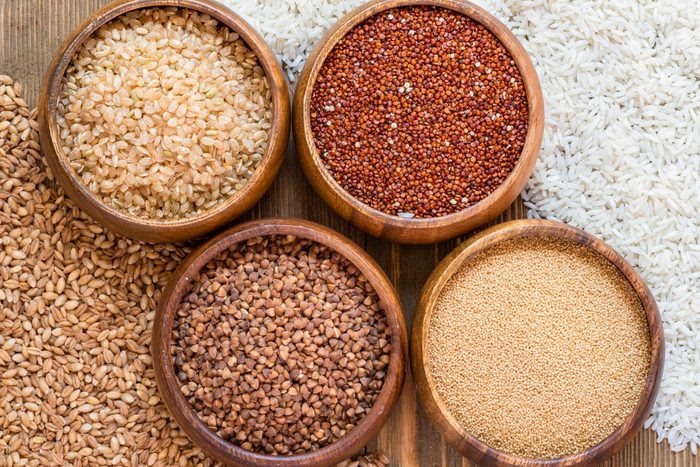
12. Grab the bulk grains
Foods like brown rice, quinoa, and popcorn kernels are whole foods that are often available in the bulk section of your favorite grocery store.
“Single-ingredient whole grains are high in B vitamins, fiber, and other heart-healthy nutrients,” says Murthy. “Since they only have one ingredient and they are minimally processed, they are cheaper than foods like sugary, flavored oatmeal packets, or instant microwaveable popcorn.”
Dried grains, while usually more affordable, can also be cooked in large quantities and frozen for meal prepping, Zhang says. Even starchy grains like pasta and bread can be frozen to extend freshness, she adds.
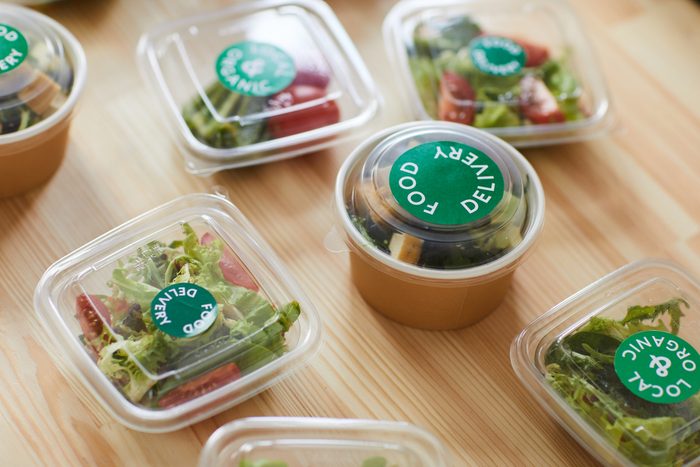
13. Order from the TooGoodToGo App
“Too Good To Go connects consumers with local participating restaurants that offer food at a discounted rate to reduce waste,” Hayes explains. If restaurants have more food waste, eventually, that cost is passed to the patrons.
But by using Too Good To Go, a restaurant is able to decrease its waste—which translates to consumers in a few ways. “The consumer is able to decrease their spending by purchasing the food at a discounted rate, which helps keep the prices steady for the future,” she says.
“When using the app, just look for places that offer healthier items and avoid those that are only offering unhealthy alternatives like fried or fast food.”
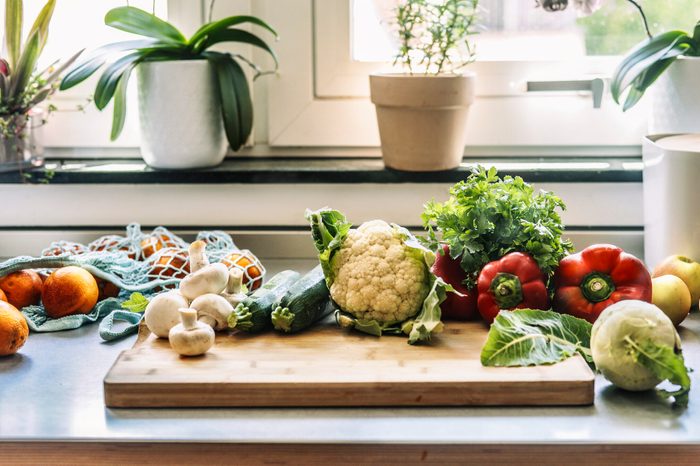
14. Shop with Flashfood
Flashfood is another grocery app that offers food items up to 50% off their retail price. “Our most popular item is our $5 produce box, a 10-pound box of assorted fruits and vegetables,” explains Esther Cohn, Flashfood’s VP of Communications & Public Affairs. This is a great way to increase your produce consumption affordably—and you may get to try something new.
“We call this the dragon fruit effect,” she says. “We’ve heard from many shoppers that they tried dragon fruit for the first time using Flashfood because they got one in their produce box.”
The Flashfood app updates items daily based on what participating stores have available. “This means if you have ground beef on your list, but Flashfood has ground turkey 50% off, get that instead,” Cohn says. “These are products in surplus or items nearing their best-by date that would otherwise go to waste despite being perfectly good to consume.”
If Flashfood doesn’t operate in your area, Cohn says to let them know. The app currently works with more than 2,300 stores in the U.S. and adds new stores to its platform daily.
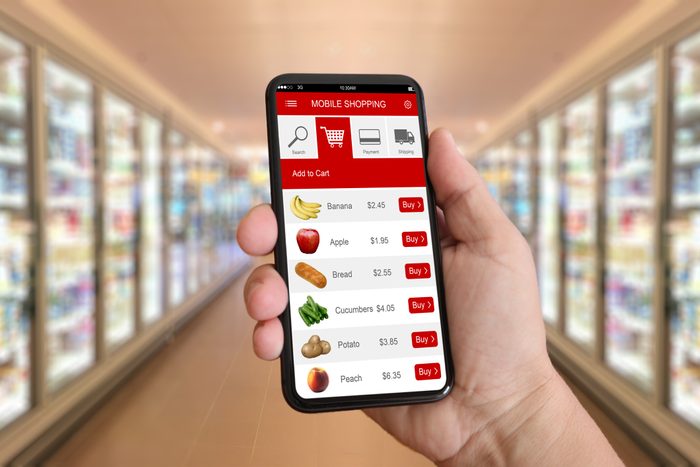
15. Use grocery store apps
Cohn also recommends checking to see if your local grocery store has an app. “Those typically offer app-exclusive deals that are just as worthwhile to take advantage of.”
Zumpano adds that shopping around can really help lower your grocery bill—though you might need to make a few stops. But with a bit of strategic prep, you can use these apps to find the best deals for efficient, cost-saving shopping.
For example, Costco has its famous $5 rotisserie chicken, while discount retailers like Aldi offer low-cost whole grain sides, Allen says. Both stores have apps you can browse to plan your shopping list around your budget.
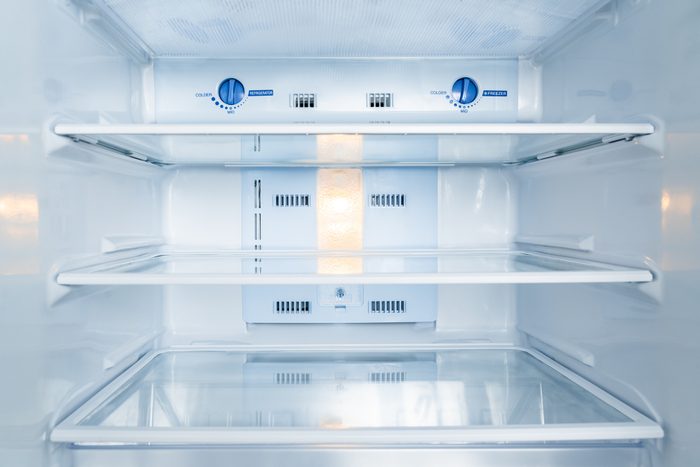
16. Clean your fridge
Keeping your fridge and pantry clean helps you create meals with items you already have in your kitchen, Hayes says. “This will reduce what you need to purchase in-store and helps with spoilage.”
It’s simple: when your fridge and pantry are clean and organized, it’s easier to notice that half-used bell pepper before it goes off. It also prevents overbuying since you can better keep track of what you actually need.
According to the U.S. Department of Energy, keeping your fridge clean also:
- Ensures it’s running properly, promoting proper airflow and cooling
- Clear away mold or bacteria that can spoil food faster
- Prevent cross-contamination from spoiling or expired foods
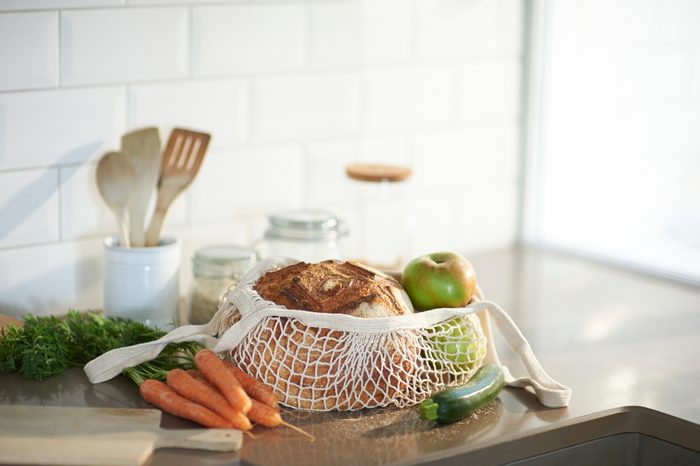
17. Don’t shop hungry
“Avoid shopping when hungry,” Zhang says. “One can experience more food noise if they go shopping for food on an empty stomach.” That means you’re more likely to splurge on items you don’t actually need.
In fact, 2024 research published in Frontiers in Nutrition shows that people who shop when hungry are more likely to make impulsive, indulgent, and less healthy food choices.
To put that into dollar amounts, a 2024 survey commissioned by the Dole Food Company found that, on average, hungry shoppers spend $26 more on a trip to the store than they would have otherwise.

18. Consider alternatives for pricey items
“Eggs are a staple in many diets as they are considered a complete protein source,” Hayes says. “With the cost of eggs increasing, look into other protein sources that are not as expensive.” Things like chickpeas, black beans, and tofu are good options. “They are filling and are typically less costly.”
Another cost-saving swap? Avoid buying marinated, flavored, or pre-seasoned foods, Zhang suggests. Marinate chicken or meat in bulk at home and freeze them in portions instead of buying pre-packaged flavored versions.
Here are 20 other healthy meal prep hacks for more nutritious food on a budget.
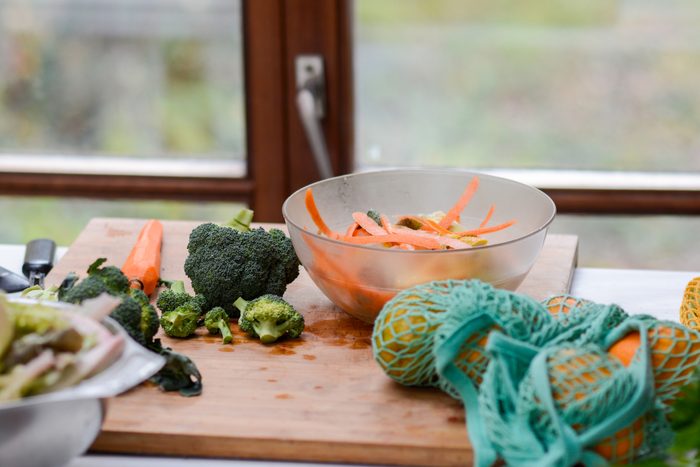
19. Buy whole foods
Along with pre-marinated foods, Zhang advises avoiding pre-made meals, salad kits, pre-cut products and meat, pre-cooked and peeled eggs, variety pack snacks, instant mixes like mashed potatoes, and single-serving items.
“In general, when people are shopping and have limited time, that $3 head of lettuce and $2 tomatoes seems like a lot when the alternative is a pre-washed and packaged [salad] bag with croutons and a few carrot shreds for essentially the same price,” Allen says. We often just gravitate toward the packaged item out of convenience and the perception of cost-benefit.
But whole food items go a lot further. “Buy whole carrots, broccoli heads, whole watermelon instead of the pre-cut, pre-washed versions—they tend to cost more,” Zumpano adds.

20. Grow what you can
“Having your own garden for items your family tends to consume a lot can help with saving in the long run, but it is not something that is feasible for everyone,” Hayes says. “If you can have your own garden, great—but if not, purchasing from local growers and farmers can help with cost, quality, and the community.”
But even if you can’t commit to a full garden, a little bit still makes a difference. “Right now, dandelions are in bloom—they are free and so good for you,” Allen says. So, instead of splurging on pricey microgreens at the store, she suggests adding dandelion leaves to your salad, “and the blooms can be dipped in a chickpea batter and sauteed in coconut or olive oil for a rich treat.”
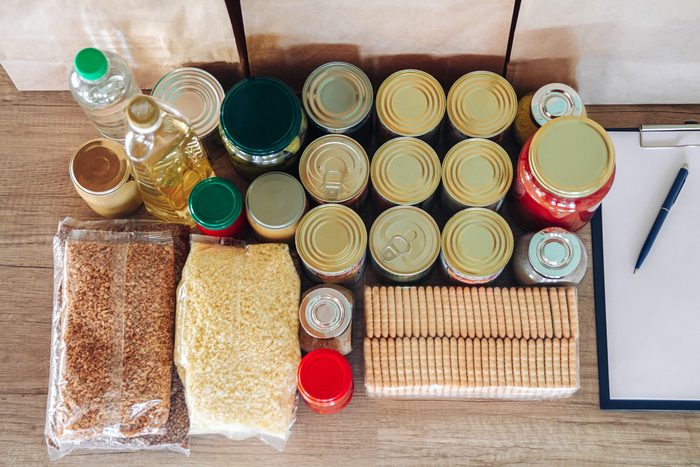
21. Know what local resources are available
“Check with churches in the local area as well as food banks,” Hayes suggests. “Be on the lookout for community events that are posted on social media that are aimed at helping with food insecurity.”
If you have kids, she says that some schools participate in programs with local food banks, such as the Feeding America BackPack Program. “These provide food for school-aged kids to take home on Fridays that provide nourishing meals over the weekends,” she says. “The 2-1-1 helpline can also assist with connecting to local resources like food pantries or nonprofits.”
For daily wellness updates, subscribe to The Healthy by Reader’s Digest newsletter and follow The Healthy on Facebook and Instagram. Keep reading:




















